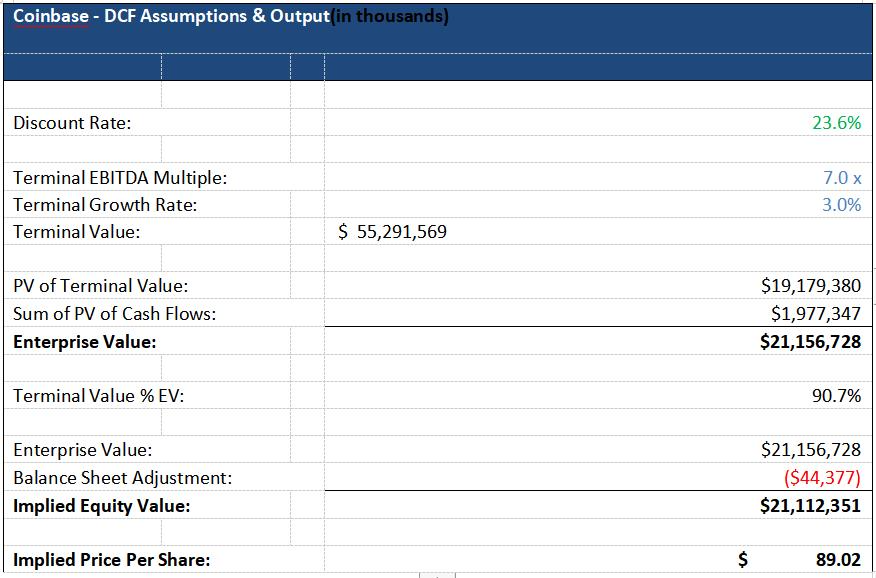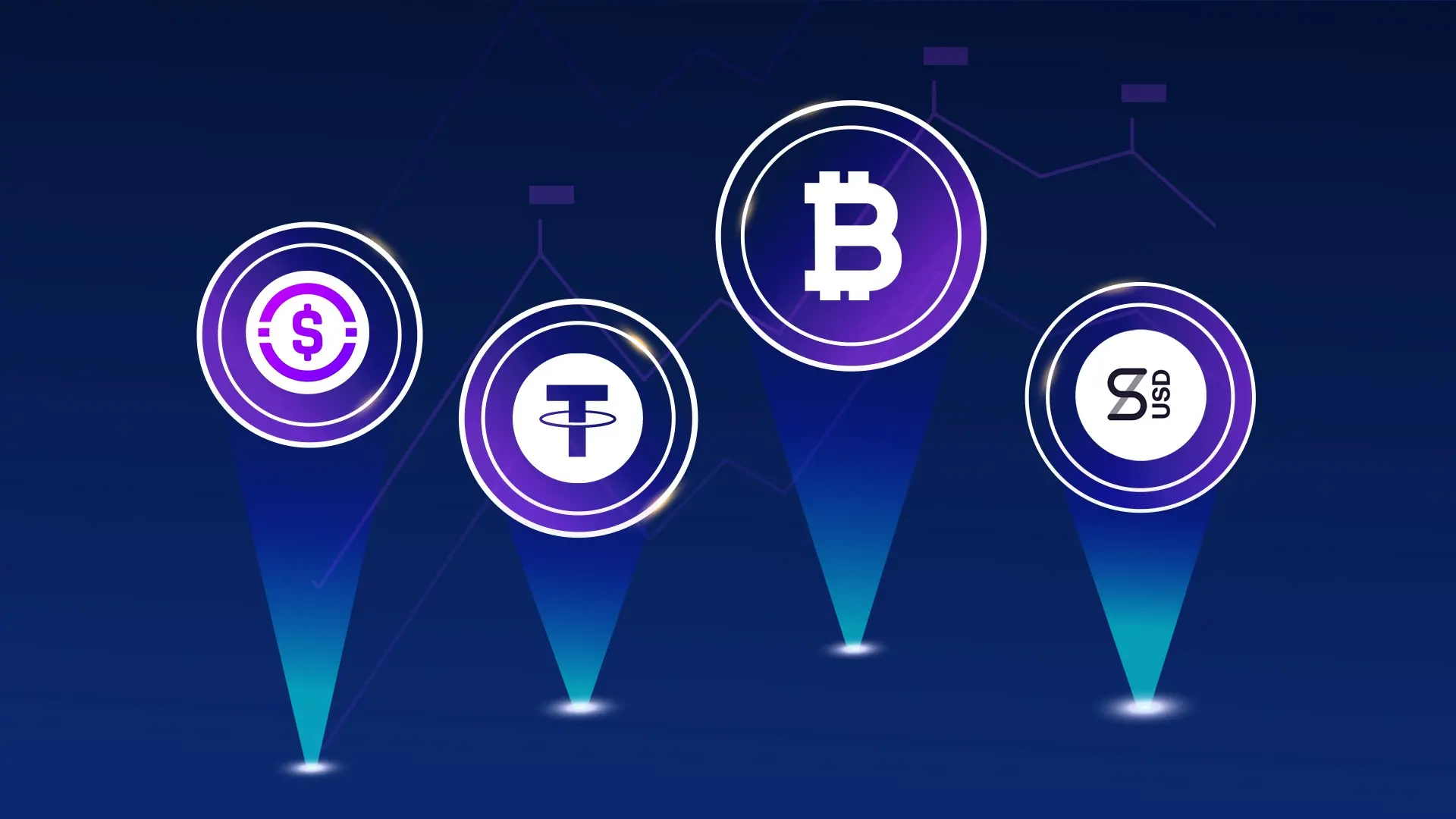In-depth Analysis of Coinbase's Investment Logic and Growth Potential
Author: LD Capital
I. Investment Logic
1. Asset Class - Exposure to Compliant Crypto Market via US Stocks
This year, Coinbase's stock has risen over 120%, attributed to Bitcoin's 65% increase since the beginning of the year and a 35% rise in tech stocks. Following the US stock market and the crypto market, this dual market correlation can yield returns that surpass both markets when the trend is upward.
The chart shows the correlation between COIN and ETH, as well as other related assets (MARA, HUT, GLXT, COIN, MSTR), which closely follow ETH's movements.

Source: LD Capital
2. Growth Potential of Core Business Yet to be Realized
Coinbase's core business is trading revenue, which is affected by macroeconomic and industry cyclicality. The halving event can lead to market speculation, resulting in increased trading volume. However, the continuation of a high inflation and high-interest rate environment that is unfavorable for crypto growth will still negatively impact Coinbase's core business over the next 8-12 months.
For Coinbase, which went public in May 2021 and encountered a bear market, growth is the core driver of stock price increase. Coinbase's global platform and derivatives trading were only officially launched in May this year, with the global platform expected to bring more spot trading volume, and the derivatives business is a significant driver for increasing trading revenue. On August 14, Coinbase announced its official entry into Canada, launching alongside Interac payment rails and other partnerships, indicating Coinbase's focus on growth (regional and business expansion). Therefore, although business growth will be constrained by external conditions over the next 12 months, the potential for revenue growth within 24 months is substantial due to many untapped positives.
3. First Half EBITDA Exceeds Expectations, Overdrafting Second Half Profit Expectations
In Q2 2023, Coinbase achieved an adjusted EBITDA of $194 million, significantly exceeding expectations, primarily due to the cost-cutting plan implemented a year ago, which led to a nearly 50% year-over-year reduction in operating expenses. Due to the continuation of unfavorable macro factors, the crypto cycle is in a deep bear market, compounded by external compliance pressures, it is believed that this non-organic growth through cost-cutting will overdraft profit growth in the next two quarters. Profit expectations for the second half of the year and into next year are poor.
4. Coinbase's Aggressive Development of Ancillary Businesses Brings New Growth Points
· International Platform and Derivatives Trading Business - Coinbase's derivatives exchange is still in its early stages, currently serving 50 institutions with a contract trading volume of $5.5 billion; however, Q2 only launched an API beta version with a limited number of clients. Therefore, some next steps for Coinbase include integrating it into retail applications. The official launch of the international platform and derivatives products will bring substantial revenue growth.
· USDC Business - Coinbase is acquiring a minority stake in Circle, without disclosing specific investment figures. This investment's nature means that Coinbase and Circle will have greater strategic and economic alignment in the future development of the financial system. It indicates that USDC will have broader development prospects, potentially expanding from cryptocurrency trading to foreign exchange and cross-border transfers. Coinbase's senior executives downplayed competition with PayPal in the stablecoin space (PYUSD's $44 million supply market share is still small). Coinbase and Circle will continue to earn revenue from interest income on USDC reserves. According to the new arrangements between the two parties, this income will continue to be allocated based on the amount of USDC held on the platform, and they will also equally share interest income generated from the broader distribution and use of USDC.
· On-chain Business - After the launch of Base, the additional MEV income generated is direct profit that Coinbase can obtain. In addition to direct profit opportunities, Coinbase CFO Alesia stated in a conference call that the usage of Base will provide opportunities for all other products and services offered by Coinbase, such as users utilizing Coinbase's payment channels and wallet products, which will also bring ancillary revenue. Additionally, the ETH staking business brings at least $100 million in revenue to Coinbase.
5. Coinbase May Continue to Gain More Market Share from Binance, Becoming the Largest Exchange
The SEC's charges against Binance are more severe, as it is accused of operating an unregistered securities exchange, broker, and clearing agency, similar to CB, but the SEC also accuses it of engaging in more FTX-like activities: deception, cross-entity asset mixing, and trading against customers. The SEC has not made similar accusations against Coinbase. The global crackdown on competitor Binance is favorable for Coinbase, meaning that Coinbase is likely to replace Binance as the most influential exchange.
6. Necessary Compliance Qualifications Make Coinbase One of the Biggest Beneficiaries of Spot ETFs
After the approval of traditional asset management institutions' spot ETF applications, it is a huge benefit for Coinbase, as a potential custodian, which will earn significant income through AUCC (Average Custody Cost per Year) from the custody of the soon-to-be-launched spot ETFs. In the future, it is believed that many additional revenues can also be obtained through clearing and settlement and other services. However, many issues still need to be resolved before this, and there is a long time window.
7. Regulatory Pressure Leads to Increased Compliance Costs
Although Coinbase has performed well during the ongoing crypto winter, the persistent regulatory uncertainty remains the foundation of the company's negative outlook. Regarding the SEC's lawsuit against Coinbase, the company is seeking to dismiss the lawsuit filed by the SEC in June (accusing the company of operating an unregistered exchange, broker, and clearing agency). The SEC may not necessarily win, and it is likely to end with a settlement, which could significantly impact the company's profits (e.g., Kraken's $30 million fine). This will affect the company's fundamentals, but the market may interpret it as a positive.
Regarding the development of financial services similar to bank/financial institution deposits, Coinbase may need to obtain licenses from the Federal Reserve System, the Federal Deposit Insurance Corporation (FDIC), the Office of the Comptroller of the Currency (OCC), or state banking regulators, and similar licenses will be required in other regions, which will increase compliance costs. Additionally, without obtaining the necessary licenses, the company faces the risk of fines and shutdowns at any time. The varying regulatory environments across regions also limit Coinbase's international business expansion.
In summary, it is currently believed that Coinbase's profits will continue to be suppressed over the next 12 months, but the potential for revenue and profit growth will be released within 24 months. The revenue growth that has not yet been fully priced in includes: 1) The official launch of the international platform and derivatives products will bring substantial revenue growth. 2) Continued growth of the staking business, including sorting revenue from the Base chain (and other chains); revenue from staking; incremental usage of other Coinbase products and services (wallet, etc.) brought by on-chain users; 3) Potential recovery of USDC volume leading to increased interest income from reserves and growth in fees generated from distribution. However, due to the strong correlation with the crypto market, it is expected that under the backdrop of a macro environment that is not optimistic, the trading revenue from the core business will not see significant growth in the 8-12 months of high inflation and high-interest rates that are unsuitable for crypto growth. However, in the subsequent bull market, the growth rate will exceed the 515% growth seen in 2021.
Valuation indicates that in the base case, Coinbase's fair value is $89, while the current price of $74 is undervalued by 16%; however, considering the sensitivity of the DCF valuation model to projected fiscal year business growth and terminal EV/EBITDA multiples, it should be viewed in conjunction with the endogenous cycle of crypto market trading and market sentiment. In the short term, the stock price faces downward pressure due to the deep bear market in both US stocks and the crypto market. A more practical operational suggestion is to sell in the next 12 months, followed by buying in the next 24 months. At an EV/EBITDA of 7x, the fair value is $89, and at 14x, the fair value is $170.
II. Company Background and Business Introduction
Founded in 2012, Coinbase operates a diversified cryptocurrency business and is the largest crypto asset trading platform in the United States, having served over 108 million customers. Users can buy, sell, and trade crypto assets through the platform; on April 14, 2021, Coinbase successfully went public on NASDAQ, becoming the "first cryptocurrency stock."
In Q2 2023, its trading revenue reached $327 million, accounting for about half of its net sales, which is also its core business revenue. Coinbase also earned over $200 million from interest income related to its partnership with USDC, the second-largest stablecoin in the market. Although it remains a smaller business line, it is considered a major project for expanding ancillary revenue, with other product lines including cloud services and high-yield token "staking" products.
In terms of specific business lines,
1) Coinbase App - Targeting Ordinary Traders
Users can trade tokens on the platform. The first option for fee income is to pay trading fees according to a transparent pricing plan, including transaction fees and spreads added to trades when consumers buy, sell, or convert crypto assets in fiat-to-crypto or crypto-to-crypto transactions. These trading fees are fixed as a percentage of the user's trading volume on the company's platform, simplifying trading (excluding small transactions, which have fixed fees), while trading volume for advanced trading is tiered. The second option is through the company's subscription product, Coinbase One, where consumers pay a monthly fee instead of trading fees until reaching a certain trading volume threshold. However, for simple trades, spreads will still be charged.
The Coinbase application has expanded proprietary product experiences, providing its customers with the ability to make peer-to-peer payments, remittances, direct deposits, and through its Coinbase Card (a debit card branded by Coinbase). Additionally, users can earn crypto assets through various means, including staking rewards, DeFi yields, and certain unique methods for specific crypto assets.
For most consumers, staking crypto assets is a technical challenge. Independent staking requires participants to run their own hardware and software and maintain close to 100% uptime. The company offers true on-chain proof-of-stake services, reducing the complexity of staking, allowing its consumers to earn staking rewards while fully owning their crypto assets. In return, the company takes a commission on all staking rewards. Recently, its Cloud product has also integrated the on-chain staking protocol Kiln, which allows for Ethereum staking below the 32 ETH limit.
2) Two Wallet Products
Web3 Wallet
Consumers can access third-party products by adding a "web3 wallet" in the Coinbase app. The web3 wallet enables the company's customers to interact with certain Dapps, including trading on decentralized exchanges or accessing art and entertainment services. This product provides convenience for consumers to easily access and interact with Dapps, sharing the responsibility of knowing and storing customer security keys between consumers and Coinbase, making wallet recovery possible. The company profits by charging fees for certain transactions on decentralized exchanges.
Coinbase Wallet
Coinbase also offers a software product called Coinbase Wallet to consumers in over 100 markets, allowing them to participate in and interact with Dapp and crypto use cases without a central intermediary. The Coinbase Wallet product experience is similar to the Web3 Wallet but has key differences, including consumers fully controlling their private keys and seed phrases, and having a broader range of assets and use cases in web3. The company profits from some transactions conducted on Dapps, such as charging fees for fiat-to-crypto transactions and/or for trades on decentralized exchanges.
3) Institutional Business
Coinbase has two types of products serving institutional clients (including but not limited to market makers, asset management companies, asset owners, hedge funds, banks, wealth platforms, registered investment advisors, payment platforms, and public and private companies).
Coinbase Prime is a comprehensive platform that meets all institutional spot crypto needs in an agency capacity. It provides institutions with trading, storage, transfer, staking, and financing services. Through Coinbase Prime, institutions can access deep liquidity pools in the crypto market and obtain best price execution due to the company's ability to connect to a series of trading venues, including the Coinbase Spot Market. The company offers volume-based pricing and charges trading fees for each matched trade.
It also provides market infrastructure for trading venues through Coinbase Spot Market and Coinbase Derivatives Exchange.
The first regulated derivatives product launched on the Coinbase Derivatives Exchange is the Nano Bitcoin Futures and Nano Ethereum Futures contracts. Coinbase is the first crypto-native platform to be recognized in the regulated derivatives market. It provides opportunities for other derivatives intermediaries to trade on its derivatives exchange. Pending regulatory approval, the company will directly offer these derivatives to its clients (currently only available to institutions).
4) Developer Suite
The developer suite includes several of the latest products, including Coinbase Cloud and Coinbase Pay.
Coinbase Cloud provides crypto payment or trading APIs, data access, and staking infrastructure. These tools allow companies to build crypto products faster and simplify interactions with blockchains. Coinbase Pay and Coinbase Commerce enable developers and merchants to more easily integrate crypto transactions into their products and businesses.
III. Financial Analysis
1. Business Model and Revenue Growth
Breaking down revenue segments, trading revenue remains the primary source of income, with ancillary businesses growing alongside trading revenue. However, it can be seen that in Q3 and Q4 of 2022, trading revenue accounted for 61% and 52% of total revenue, respectively, while in Q1 2023, it accounted for 48%. The development of other businesses, such as subscription and services, has also brought significant revenue to Coinbase and is on an upward trend.
However, trading revenue will show explosive growth when a bull market arrives, while it tends to decline in a bear market; subscription services and other businesses may see stable growth during bear markets, accompanied by trading revenue growth in bull markets.

Business Revenue Classification
Source: https://businessquant.com/coinbase-revenue-by-segment
Trading Revenue is the main source of income for Coinbase, including trading fees: Coinbase earns money by buying and selling cryptocurrencies. It usually depends on the transaction value or may depend on fixed income. Spread: This is the difference between the buying and selling price of cryptocurrencies. Conversion Fees: These fees convert one cryptocurrency into another and come from the company's trading revenue stream. Over-the-Counter Trading: This service is aimed at institutional buyers and large transactions or high-volume traders. Margin Trading: It also allows users to borrow from the platform, involving interest and borrowing fees paid by users. Payment Processing Fees: It also allows users to make payments using cryptocurrencies from its platform.
Coinbase's total trading revenue in Q1 2023 was $375 million. Trading revenue in Q4 2022 was $322 million, and in Q3 2022, it was $366 million. It accounted for 48.5% in Q1 2023.
Subscription and Service Revenue
Coinbase offers subscription services, including Coinbase Pro, Coinbase Prime, and Coinbase Custody.
Coinbase Pro is an advanced trading platform for professional and institutional investors. It offers certain free features as well as premium subscriptions for advanced features. Coinbase Prime is designed for institutional investors, providing enhanced trading features, dedicated account management, and access to liquidity solutions. Coinbase Securities typically provides secure custody solutions for institutional clients to store cryptocurrencies. It also provides insurance coverage for digital assets.
In Q3 2023, Coinbase's subscription and service revenue was $210 million, compared to $283 million in Q3 2022 and $240 million in Q4 2022, showing continuous growth, reaching a new high of $362 million in Q1 2023. Coinbase earns substantial revenue from subscription services, accounting for 46.82% in Q1 2023.
Other Revenue
Coinbase's other revenue comes from the following channels: Coinbase Commerce; Coinbase Cards; interest income; institutional services; and other products and services.
Other revenue accounts for about 4.5%. In Q3 2022, it was approximately $14 million, increasing to $24 million in Q4 2022. In Q1 2023, it grew threefold compared to Q3 2022.
Regional Revenue shows that although Coinbase's customers are spread across over 100 countries, the largest concentration is in the United States, accounting for about 40%, followed by the UK/Europe, accounting for about 25%. However, the proportion of revenue from the US region from FY2019 to 2022 was 78%, 76%, 81%, and 84%, far exceeding other regions. In August of this year, Coinbase announced its entry into the Canadian market, but growth in other regions will be limited by local regulatory environments and competition from local exchanges.

Source: Capital IQ
2. Profit Breakdown
Coinbase's overall profit margin is very high, which is a main characteristic of SaaS companies, with a profit margin of 46% in 2021.
Most of the profit is still distributed among the aforementioned trading revenue and subscription services. The MEV income from the staking business and the income from USDC are reflected in other revenues (with the staking business income being $100 million and USDC business income being $200 million); bond repurchases reduce interest expenses ($5.4 million), which is expected to increase net profit margins, but the impact is minor.

Source: Capital IQ
Staking Business and Base MEV Income
Coinbase is the sole Sequencer for Base, which is why Coinbase can obtain all priority gas profits generated from sorting on the Base chain.
Based on L2 revenue = L2 fees - L1 data storage fees - L1 verification costs
Using the current accumulated fees from Base to backtrack the sorting fees, it is estimated that $5.46 million minus half of $3.54 million can provide Coinbase with $1 million (but in reality, Coinbase relies on charging a 25%-35% commission on staked ETH as income).

Source: Dune
The income from the Base chain for Coinbase reaches $1 million (if calculated to the actual absolute value received by Coinbase, it would be smaller), and looking at the amount of ETH staked by Coinbase, it ranks first among all CEXs with a market share of 8.6%, with total rankings second only to Lido. The realized ETH income is $187k, approximately $300 million, of which Coinbase receives a commission of 25%-35%, resulting in about $100 million in income from the staking business.

Source: Dune
Coinbase's EBITDA remains around 40% of revenue, which will decrease when core revenue cannot grow due to cycles and macroeconomic factors and when external costs increase due to regulatory penalties. With the arrival of a bull market, the EBITDA/revenue ratio will correspondingly increase.
USDC Business
Currently, Coinbase holds $232 million in USDC on its platform, second only to Binance. Although due to the banking crisis in Q1, USDC saw a significant re-minting following the failure of Silicon Valley Bank, and Binance's conversion of USDC to another stablecoin led to a decline in USDC's market value. However, Coinbase CEO Brian believes that in the past 6 to 7 weeks, the data they possess shows a net growth in USDC's market value, which is an important data point. He also mentioned that US regulatory risks may intensify, and people believe that USDC has more American relevance compared to other stablecoins like Tether, which may put USDC in a difficult position in the short term.

Source: Dune Analytics
Circle achieved $779 million in revenue in the first half of the year, surpassing the $772 million for the entire year of 2022. It generated $219 million in EBITDA in the first half, exceeding last year's total of $150 million; however, the overall market value of USDC has declined, with its stablecoin market share currently at only 21%. This may also be a strategic consideration for bringing Coinbase in as an investor and planning to launch USDC on six new blockchains between September and October to prevent further declines in market share. Clearly, Coinbase values the stablecoin business and needs to generate as much revenue as possible from it.
3. Costs
In January 2023, the company announced and completed a restructuring that affected approximately 21% of the total number of employees as of December 31, 2022 (hereinafter referred to as "2023 Restructuring"). The 2023 Restructuring aims to address the ongoing impact of the crypto economy and the market conditions affecting ongoing business priorities to manage the company's operating expenses. As a result, approximately 950 employees from various departments and locations were laid off. As part of the layoffs, they received severance compensation and other personnel benefits.
Cash payments related to this restructuring were essentially completed in Q2 2023, with the remainder expected to be paid by December 31, 2023. The significant reduction in operating costs due to reduced labor costs is also the reason why Coinbase's EBITDA has been positive and significantly exceeded expectations for two consecutive quarters in Q1 and Q2 this year.
In terms of operating cost expenditures, on March 3, 2023, the company completed the acquisition of One River Digital Asset Management, LLC. ("ORDAM"), acquiring all issued and outstanding membership interests of ORDAM. ORDAM is an institutional digital asset management company registered with the U.S. Securities and Exchange Commission (SEC) as an investment advisor. The company believes that this acquisition aligns with its long-term strategy and can provide more opportunities for institutional participation in the crypto economy. The total consideration paid in the acquisition was $96.8 million.

Source: Capital IQ
4. Borrowing Costs
On August 7, 2023, Coinbase announced a cash tender offer to purchase up to $150 million of its senior unsecured notes maturing in 2031 at a price of $0.645 (before August 18) or $0.615 (after August 18 but before September 1). Coinbase will fund this transaction through its operating cash flow. This tender offer follows the repurchase of $645 million of 0.5% convertible senior notes maturing in 2026 at a 29% discount in June 2023, amounting to approximately $45.5 million in cash. Given that Coinbase has ample liquidity and no imminent refinancing risks, this transaction is considered profitable and will not lead to a cash crisis for Coinbase. The transaction will also further increase excess cash reserves against debt due to the provided discount and reduce its annual interest expense by approximately $5.4 million.
Theoretically, Coinbase's proactive use of cash tender offers to buy back some future maturing debt to reduce the debt burden helps lower the company's future debt interest expenses and improve financial stability. Enhancing market confidence: The improvement in the company's debt repayment ability and financial strength may boost market confidence in the company, helping to raise stock prices and credit ratings, and also helping to lower borrowing costs.

IV. Valuation
DCF Analysis
To perform a discounted cash flow analysis, the current D/V (67%) and E/V (33%) ratios were used based on Coinbase's capital structure. The leveraged equity beta for Coinbase was calculated to be 3.15. Using the CAPM model, assuming a market risk premium of 7% and a risk-free rate of 5.5%, the cost of equity was calculated. The loan cost of the company's senior notes was used, combined with a 27% effective tax rate to obtain the after-tax loan cost. The company's weighted average cost of capital (WACC) was calculated to be 23.58%.

Given the current high-interest rate environment, it is believed that this high level may persist until a decline in July next year. Therefore, the terminal value calculated in the DCF model is biased towards a more conservative level. The growth rates for FY2023-2025 are estimated at -5%, 10%, and 500%.

Valuation Rationale and Recommendations
Valuation indicates that in the base case, Coinbase's fair value is $89, while the current price of $74 is undervalued by 16%; however, considering the sensitivity of the DCF valuation model to projected fiscal year business growth and terminal EV/EBITDA multiples, it should be viewed in conjunction with the endogenous cycle of crypto market trading and market sentiment. In the short term, the stock price faces downward pressure due to the deep bear market in both US stocks and the crypto market. A more practical operational suggestion is to sell in the next 12 months, followed by buying in the next 24 months. At an EV/EBITDA of 7x, the fair value is $89, and at 14x, the fair value is $170.
Recommendation: Investment Cycle: Sell in the next 12 months
Buy in the next 24 months, with a target price of $89 at EV/EBITDA of 7x and $170 at 14x.
V. Risks - Regulatory Uncertainty
Coinbase is seeking to dismiss the lawsuit filed by the SEC in June in the New York federal court against the compliant crypto trading platform Coinbase, Inc. and its parent company Coinbase Global, Inc., accusing the company of operating an unregistered exchange, broker, and clearing agency.
Key Points of the Lawsuit: According to the Securities Exchange Act of 1934, the functions of brokers, exchanges, and clearing agencies in traditional securities markets are separate, but the Coinbase platform combines all three functions and has not registered with the SEC or obtained any applicable exemptions. For years, Coinbase has defied the regulatory structure, evading Congress and SEC disclosure requirements.
During the same period, Coinbase also provided two additional services to investors, operating as an unregistered broker: Coinbase Prime (Prime), which routes orders for crypto assets to the Coinbase platform or third-party platforms; and Coinbase Wallet, which routes orders through third-party crypto asset trading platforms to access liquidity outside the Coinbase platform.
Coinbase has earned trading revenue by providing crypto assets while ignoring the fact that these assets have securities attributes. Moreover, since 2016, Coinbase has understood that crypto assets should be regulated under securities laws, positioning itself as a compliant platform in its marketing; although it verbally expresses a willingness to comply with applicable laws, it has consistently allowed crypto assets that meet the Howey Test standards to be traded.
Since 2019, Coinbase has offered staking services, allowing investors to earn returns through staking, with Coinbase earning a commission of 25-35%. However, Coinbase has never registered with the SEC regarding the issuance and sale of staking projects, depriving investors of important information about the program, harming investors' interests, and violating the registration provisions of the Securities Act of 1933.
All income earned by Coinbase flows to its parent company CGI, which is actually the true controller of Coinbase, thus CGI also violates the same trading laws as Coinbase.
The SEC seeks a final judgment:
(a) A permanent injunction against the defendants from violating relevant provisions of the securities laws;
(b) An order for the defendants to disgorge illegal gains and pay pre-judgment interest;
(c) Civil penalties against Coinbase and requiring it to provide appropriate or necessary equitable relief for investors.
(Note: In the SEC's sought ruling against Binance, it also permanently prohibits it from engaging in financial-related business.)
Summary
In summary, it is currently believed that Coinbase's profits will continue to be suppressed over the next 12 months, but the potential for revenue and profit growth will be released within 24 months. The revenue growth that has not yet been fully priced in includes:
1) The official launch of the international platform and derivatives products will bring substantial revenue growth;
2) Continued growth of the staking business, including sorting revenue from the Base chain (and other chains); revenue from staking; incremental usage of other Coinbase products and services (wallet, etc.) brought by on-chain users;
3) Potential recovery of USDC volume leading to increased interest income from reserves and growth in fees generated from distribution. However, due to the strong correlation with the crypto market, it is expected that under the backdrop of a macro environment that is not optimistic, the trading revenue from the core business will not see significant growth in the 8-12 months of high inflation and high-interest rates that are unsuitable for crypto growth. However, in the subsequent bull market, the growth rate will exceed the 515% growth seen in 2021.
Appendix
Compliance Status
Coinbase's CEO believes that the MiCA bill passed in Europe, but the UK, Singapore, and Brazil are all actively working to pass legislation, with other countries leading the way ahead of the US.
At the same time, Coinbase is also working to provide regulatory clarity for the entire industry. One of the biggest issues hindering the adoption of this technology is the lack of clear rules and the enforcement regulation that has been conducted in the US so far. While other parts of the world have made significant progress in accepting crypto and web3 technologies and have established clear legislation, the US has struggled to keep up. Coinbase has an important role to play here. When the SEC refuses to engage in rule-making and opts for an enforcement regulatory approach, Coinbase has utilized the courts to help bring regulatory clarity to the US and has helped create case law. Coinbase has also actively participated in congressional activities, where bipartisan support for crypto legislation can be seen.
In just the past few weeks, the House Financial Services Committee and the House Agriculture Committee passed landmark crypto market structure legislation (FIT21) and stablecoin legislation with bipartisan support. These bills will be submitted for a full vote in the House later this year and then submitted to the Senate. Coinbase is committed to ensuring that the US does not fall behind in passing crypto legislation. It has also begun mobilizing crypto users nationwide to ensure their voices in Coinbase's democratic process are heard. Currently, one in five Americans has used cryptocurrency—this proportion is higher than those holding union cards. So far, the "Support Crypto" movement has attracted around 60,000 crypto advocates, covering 435 congressional districts. For example, regarding how we mobilized in New York City today, we held live gatherings with representatives from Senator Gillibrand's office, Mayor Adams' office, and Governor Hochul's office, along with hundreds of crypto enthusiasts in August before COINBASE.
Coinbase is regulated by various anti-money laundering and anti-terrorism financing laws, including the Bank Secrecy Act (BSA) in the US and similar laws and regulations abroad. In the US, as a registered money services business with the Financial Crimes Enforcement Network (FinCEN), the BSA requires the company to develop, implement, and maintain a risk-based anti-money laundering program, provide anti-money laundering training programs, report suspicious activities and transactions to FinCEN, comply with certain reporting and record-keeping requirements, and collect and maintain information about its customers. Additionally, the BSA requires it to comply with certain customer due diligence requirements as part of its anti-money laundering obligations, including developing risk-based policies, procedures, and internal controls designed to reasonably verify customer identities.
Coinbase has implemented a compliance program designed to prevent its platform from being used to facilitate money laundering, terrorist financing, and other illegal activities, whether domestically or in transactions with countries, individuals, or entities on the Foreign Assets Control Office (OFAC) designated list.
In the US, Coinbase has obtained the necessary licenses to operate as a money transmitter or equivalent money transmitter in the states where it conducts business, including the District of Columbia and Puerto Rico. Additionally, it has obtained a BitLicense from the New York State Department of Financial Services (NYDFS).
Outside the US, Coinbase has obtained licenses from the Federal Financial Supervisory Authority in Germany to provide crypto asset custody and trading. The company is also registered as a crypto asset trading service provider in Japan, according to the registration with the Kanto Local Finance Bureau of the Japanese Ministry of Finance, covering crypto asset and first-party payment services. In Singapore, the company operates under the Payment Services Act and is supervised by the Monetary Authority of Singapore (MAS). The company is currently in a preliminary approval status and requires final approval from MAS to become a major payment institution. Under these licenses and registrations, it is subject to a wide range of rules and regulations, including anti-money laundering, customer asset and fund protection, regulatory capital requirements, qualified and proper management, operational controls, corporate governance, customer disclosures, reporting, and record-keeping.
Coinbase's subsidiary, Coinbase Custody Trust Company, LLC, is a limited-purpose trust company approved by New York State and is regulated, reviewed, and supervised by the NYDFS. NYDFS regulations impose many requirements regarding various compliance obligations, including but not limited to operational restrictions on the nature of crypto assets that can be held in custody, capital requirements, BSA and anti-money laundering program requirements, restrictions on related party transactions, and notification and reporting requirements.
Coinbase provides services to customers through an electronic money institution authorized by the UK's Financial Conduct Authority and the Central Bank of Ireland. The company complies with rules and regulations applicable to the European electronic money industry, including rules related to fund custody, corporate governance, anti-money laundering, disclosure, reporting, and inspections.
Coinbase has established a set of policies and practices to assess each crypto asset it considers listing or custody, and it is a founding member of the Crypto Rating Council. Coinbase's brokerage business is operated by Coinbase Capital Markets and Coinbase Securities, which are registered with the SEC as brokers under the Securities Exchange Act of 1934.















